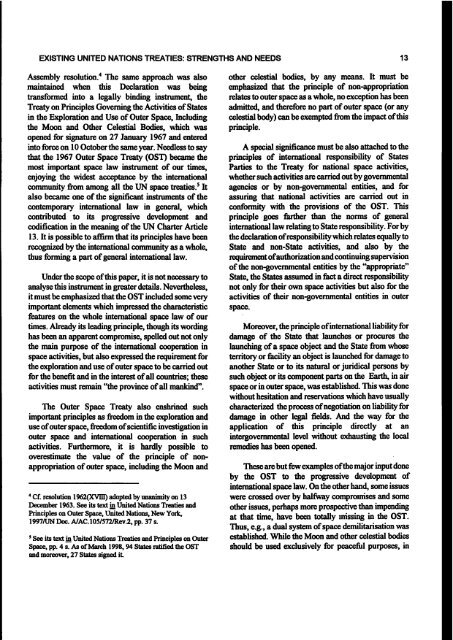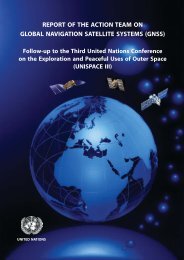Proceedings of the Workshop - United Nations Office for Outer ...
Proceedings of the Workshop - United Nations Office for Outer ...
Proceedings of the Workshop - United Nations Office for Outer ...
- No tags were found...
Create successful ePaper yourself
Turn your PDF publications into a flip-book with our unique Google optimized e-Paper software.
EXISTING UNITED NATIONS TREATIES: STRENGTHS AND NEEDS 13Assembly resolution. The same approach was alsomaintained when this Declaration was beingtrans<strong>for</strong>med into a legally binding instrument, <strong>the</strong>Treaty on Principles Governing <strong>the</strong> Activities <strong>of</strong> Statesin <strong>the</strong> Exploration and Use <strong>of</strong> <strong>Outer</strong> Space, Including<strong>the</strong> Moon and O<strong>the</strong>r Celestial Bodies, which wasopened <strong>for</strong> signature on 27 January 1967 and enteredinto <strong>for</strong>ce on 10 October <strong>the</strong> same year. Needless to saythat <strong>the</strong> 1967 <strong>Outer</strong> Space Treaty (OST) became <strong>the</strong>most important space law instrument <strong>of</strong> our times,enjoying <strong>the</strong> widest acceptance by <strong>the</strong> internationalcommunity from among all <strong>the</strong> UN space treaties.5 Italso became one <strong>of</strong> <strong>the</strong> significant instruments <strong>of</strong> <strong>the</strong>contemporary international law in general, whichcontributed to its progressive development andcodification in <strong>the</strong> meaning <strong>of</strong> <strong>the</strong> UN Charter Article13. It is possible to affirm that its principles have beenrecognized by <strong>the</strong> international community as a whole,thus <strong>for</strong>ming a part <strong>of</strong> general international law.Under <strong>the</strong> scope <strong>of</strong> this paper, it is not necessary toanalyse this instrument in greater details. Never<strong>the</strong>less,it must be emphasized that <strong>the</strong> OST included some veryimportant elements which impressed <strong>the</strong> characteristicfeatures on <strong>the</strong> whole international space law <strong>of</strong> ourtimes. Already its leading principle, though its wordinghas been an apparent compromise, spelled out not only<strong>the</strong> main purpose <strong>of</strong> <strong>the</strong> international cooperation inspace activities, but also expressed <strong>the</strong> requirement <strong>for</strong><strong>the</strong> exploration and use <strong>of</strong> outer space to be carried out<strong>for</strong> <strong>the</strong> benefit and in <strong>the</strong> interest <strong>of</strong> all countries; <strong>the</strong>seactivities must remain “<strong>the</strong> province <strong>of</strong> all mankind”.The <strong>Outer</strong> Space Treaty also enshrined suchimportant principles as freedom in <strong>the</strong> exploration anduse <strong>of</strong> outer space, freedom <strong>of</strong> scientific investigation inouter space and international cooperation in suchactivities. Fur<strong>the</strong>rmore, it is hardly possible tooverestimate <strong>the</strong> value <strong>of</strong> <strong>the</strong> principle <strong>of</strong> nonappropriation<strong>of</strong> outer space, including <strong>the</strong> Moon and4 Cf. resolution 1962(XVIII) adopted by unanimity on 13December 1963. See its text in <strong>United</strong> <strong>Nations</strong> Treaties andPrinciples on <strong>Outer</strong> Space, <strong>United</strong> <strong>Nations</strong>, New York,1997/UN Doc. A/AC. 105/572/Rev.2, pp. 37 s.5 See its text in <strong>United</strong> <strong>Nations</strong> Treaties and Principles on <strong>Outer</strong>Space, pp. 4 s. As <strong>of</strong> March 1998, 94 States ratified <strong>the</strong> OSTand moreover, 27 States signed ito<strong>the</strong>r celestial bodies, by any means. It must beemphasized that <strong>the</strong> principle <strong>of</strong> non-appropriationrelates to outer space as a whole, no exception has beenadmitted, and <strong>the</strong>re<strong>for</strong>e no part <strong>of</strong> outer space (or anycelestial body) can be exempted from <strong>the</strong> impact <strong>of</strong> thisprinciple.A special significance must be also attached to <strong>the</strong>principles <strong>of</strong> international responsibility <strong>of</strong> StatesParties to <strong>the</strong> Treaty <strong>for</strong> national space activities,whe<strong>the</strong>r such activities are carried out by governmentalagencies or by non-governmental entities, and <strong>for</strong>assuring that national activities are carried out incon<strong>for</strong>mity with <strong>the</strong> provisions <strong>of</strong> <strong>the</strong> OST. Thisprinciple goes far<strong>the</strong>r than <strong>the</strong> norms <strong>of</strong> generalinternational law relating to State responsibility. For by<strong>the</strong> declaration <strong>of</strong> responsibility which relates equally toState and non-State activities, and also by <strong>the</strong>requirement <strong>of</strong> authorization and continuing supervision<strong>of</strong> <strong>the</strong> non-governmental entities by <strong>the</strong> “appropriate”State, <strong>the</strong> States assumed in fact a direct responsibilitynot only <strong>for</strong> <strong>the</strong>ir own space activities but also <strong>for</strong> <strong>the</strong>activities <strong>of</strong> <strong>the</strong>ir non-governmental entities in outerspace.Moreover, <strong>the</strong> principle <strong>of</strong> international liability <strong>for</strong>damage <strong>of</strong> <strong>the</strong> State that launches or procures <strong>the</strong>launching <strong>of</strong> a space object and <strong>the</strong> State from whoseterritory or facility an object is launched <strong>for</strong> damage toano<strong>the</strong>r State or to its natural or juridical persons bysuch object or its component parts on <strong>the</strong> Earth, in airspace or in outer space, was established. This was donewithout hesitation and reservations which have usuallycharacterized <strong>the</strong> process <strong>of</strong> negotiation on liability <strong>for</strong>damage in o<strong>the</strong>r legal fields. And <strong>the</strong> way <strong>for</strong> <strong>the</strong>application <strong>of</strong> this principle directly at anintergovernmental level without exhausting <strong>the</strong> localremedies has been opened.These are but few examples <strong>of</strong> <strong>the</strong> major input doneby <strong>the</strong> OST to <strong>the</strong> progressive development <strong>of</strong>international space law. On <strong>the</strong> o<strong>the</strong>r hand, some issueswere crossed over by halfway compromises and someo<strong>the</strong>r issues, perhaps more prospective than impendingat that time, have been totally missing in <strong>the</strong> OST.Thus, e.g., a dual system <strong>of</strong> space demilitarisation wasestablished. While <strong>the</strong> Moon and o<strong>the</strong>r celestial bodiesshould be used exclusively <strong>for</strong> peaceful purposes, in
















